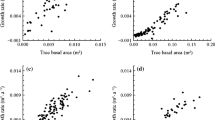Summary
The objective of this study was to examine the claim that traditional measures of competitive performance in substitutive experiments are biased towards larger plants. Results from a three-year diallele experiment of 6 marsh plant species were analyzed using both Relative Yields (a traditional analysis) and the Relative Efficiency Index (a recently proposed analysis presumed to be size-independent). In adddition, a mechanistic model of competition was used to explore the behavior of both methods of estimating competitive performance.
Results from the three-year experiment showed that Relative Yields (RYs) were correlated with the initial sizes of plants for the first two years but not the third. By the third year, RYs were highly correlated with Relative Efficiency Index values (REIs) suggesting that the effects of initial size were eventually overcome. Model results showed that RYs are inherently biased in favor of larger plants during the early phases of competition while REIs are not. Further, model analysis confirmed that the size bias associated with RYs declines with increasing duration of the experiment. It is concluded that current generalizations about the relationship between plant size and competitive ability may be biased by the procedures used to analyze competition experiments.
Similar content being viewed by others
References
Austin MP (1982) Use of a relative physiological performance value in the prediction of performance in multispecies mixtures from monoculture performance. J Ecol 70:559–570
Austin MP, Groves RH, Fresco LMF, and Kaye PE (1985) Relative growth of six thistle species along a nutrient gradient with multispecies competition. J Ecol 73:667–684
Cherrett JM (1989) Key concepts: the results of a survey of our member's opinions. In: Cherrett JM (ed) Ecological Concepts. Blackwell Sci Publ pp 1–16
Connolly J (1986) On difficulties with replacement-series methodology in mixture experiments. J Appl Ecol 23:125–137
Connolly J (1987) On the use of response models in mixture experiments. Oecologia 72:95–103
Connolly J, Wayne P, Murray R (1990) Time course of plant-plant interactions in experimental mixtures of annuals-density, frequency, and nutrient effects. Oecologia 82:513–526
deWit CT (1960) On competition. Versl Landbouwk Onderz 66:1–82
Firbank LG, Watkinson AR (1985) On the analysis of competition within two-species mixtures of plants. J Appl Ecol 22:503–517
Gaudet CL, Keddy PA (1988) Predicting competitive ability from plant traits: a comparative approach. Nature 334:242–243
Grace JB (1985) Juvenile versus adult competitive ability in plants: size-dependence in cattails (Typha). Ecology 66: 1630–1638
Grace JB (1987) The impact of preemption on the zonation of two Typha species along lakeshores. Ecol Monogr 57:283–303
Grace JB (1988) The effects of plant age on the ability to predict mixture performance from monoculture growth. J Ecol 76:152–156
Grace JB (1990) On the relationship between plant traits and competitive ability. In: Grace JB, Tilman D (eds) Perspecitives on plant competition. Academic Press, New York. pp 51–65
Harper JL (1977) Population biology of plants. Academic Press, New York
Inouye RS, Schaffer WM (1981) On the ecological meaning of ratio (deWit) diagrams in plant ecology. Ecology 62:1679–1680
Keddy PA (1989) Competition. Chapman and Hall, New York
Keddy PA (1990) Competitive hierarchies and centrifugal organization in plant communities. In: Grace JB, Tilman D (eds) Perspectives on plant competition. Academic Press, New York. pp 265–290
Keddy PA, Shipley B (1989) Competitive hierarchies in herbaceous plant communities. Oikos 54:234–241
Moore PD, Chapman SB (1986) Methods in plant ecology. Black-well Scientific Publishers, New York
Spitters CJT (1983) An alternative approach to the analysis of mixed cropping experiments. 1. Estimation of competition effects. Netherl J Agricult Sci 31:1–11
Tilman GD (1982) Resource competition and community structure. Princeton Univ. Press, Princeton, N.J.
Author information
Authors and Affiliations
Rights and permissions
About this article
Cite this article
Grace, J.B., Keough, J. & Guntenspergen, G.R. Size bias in traditional analyses of substitutive competition experiments. Oecologia 90, 429–434 (1992). https://doi.org/10.1007/BF00317702
Received:
Accepted:
Issue Date:
DOI: https://doi.org/10.1007/BF00317702




